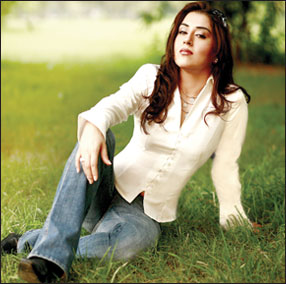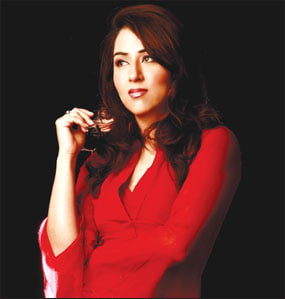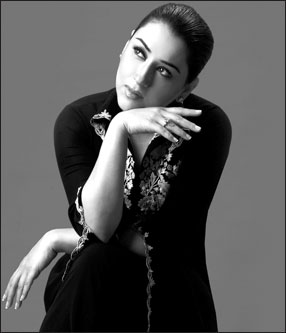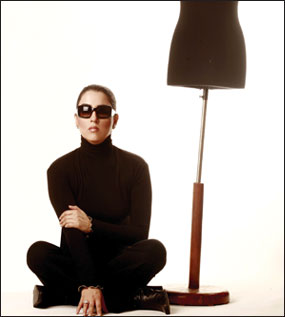|
|
| |
instep
profile
Fashion according to Farah Leghari
Farah Leghari made her first big fashion wave by designing
for Prince Charles and Camilla when they visited Pakistan last
year. Of course, before that she debuted at the Shaukat Khanum
Memorial Trust fund raiser in Karachi, for which Liz Hurley flew
down but that was only covered by Hello magazine. Instep gives
a very promising designer her due.
By Muniba
Kamal
|
| |
Going
places
Farah Leghari is a volcano and an active one at that. Always in a
hurry, she's raring to go. She's been designing for four years now
and life has never been busier. She's got kaarigars to direct, clients
to deal with, sons to give a pep talk to (they're in boarding at Aitchison
and have exams), a demanding daughter studying at Karachi Grammar
School and of course, the dream to get into retail. And for this she
has to find time. It is an especially rare commodity in her life.
Farah is adamant that she needs to get into the retail market, but
life is just too busy. So she's supplying out of her home near Abdullah
Shah Ghazi's Mazar where she lives with her parents and her sister
Nausheen 'Pepsi' Leghari who is more famous as the force behind Links,
which has become one of the most coveted and fastest going schools
in town. |
 |
| |
Just
as you enter the house is a living room that doubles as Farah's office
space. Walking in, one gets a sense of what an exciting designer she
truly is. Minimalist by Pakistan's kaam loving standard, Farah's clothes
are truly for the modern woman. The prêt line is smartly tailored
starkness or with just the hint of embroidery and when it comes to
more formal clothing, she clearly favours Swarovski crystals and funky
coins as opposed to gota kinari. And if she uses marori it is with
a modern twist. Farah Leghari by the looks of it is definitely not
into the conventional bridal market that is notorious for a lot of
embellishment for a lot of money.
"I'm not a designer whose place you walk in to and realize that
there is nothing less than 50,000 rupees," says Farah. "My
prêt collection is affordable and even when it comes to evening
wear, my heaviest outfit is not very heavy and because of that its'
not very expensive either." |
 |
| |
Farah's
prêt line will set you back around 8,000 to 12,000 rupees, while
the more formal line costs up to 18,000 rupees. That's basic, but
she has upped some prices recently.
"Now I've gone on to 38,000 rupees. These are outfits that use
the best materials and are embellished by Swarovski crystals and the
coins and other stuff I get from India."
Does she need to cross the border for embellishment?
"The quality out there is very good. Coins I get from there don't
lose colour." |
| |
Bombay
dreams
"Indians are far ahead of us in lots of ways. They know that
if they don't have quality embellishments, how will they put them
on clothes that will be exported?" asks Farah who has often traveled
to India and has her own take on the modus operandi of the Indian
fashion fraternity.
"I have been to their fashion weeks and I realized that they
(Indian designers) are geared for the world. What they have in their
local market bhara hua kapra at ridiculously low prices. It's not
designer, its kaarigars sitting in a market. Labour is very cheap.
If we are paying our kaarigars 200 rupees a day, they pay 50 rupees
or even 25 rupees a day. That's how low the poverty levels are. The
aesthetics of the average Indian, like us, is 'bhara hua kaam hona
chahiye' (it should be filled with work). It sells like hot cakes
and it doesn't make a difference to the retailer. I mean if you're
paying workers as little as 25 rupees a day, you can afford to sell
at rock bottom prices." |
 |
| |
Yet
away from this world of death by embroidery and embellishment, Farah
is convinced that Indian designers are looking beyond the traditional
Indian market.
"The top list of designers like Tarun Tahiliani and Rohit Bal
all have their boutiques but primarily all top designers in India
are only interested in the fashion weeks that they do and the buyers
that they get," she says. "The thinking of all top designers
be it in India or Pakistan is West East fusion because we are all
exposed to the West. We've all picked up on that in our lives. You
will see Rohit Bal wearing this long red jacket with gold buttons,
it's what he cultivating himself as. He is not wearing a sherwani
even though he may be selling a sherwani. He dresses funky. That
is how he wants to be perceived. He is targeting the international
circuit."
And as for Farah, she wants to participate in Pakistan Fashion Week
and build herself as a brand name. This is one designer who is sure
that the fashion week route is the one she wants to take.
Fashion
week ahoy!
Even though she may not be the most experienced designer in the
industry, Farah has a clinical approach to fashion week.
"A fashion week is a glammed up affair where buyers are your
main priority, not individual clients," she defines her perception
of the event that has the fashion industry buzzing and debating
about the merits and demerits of participating in it.
"Your clients may be there on your guest list but they are
not the ones you are doing business for that night. It's about buyers
who are tagging your clothes and thinking about buying them in quantity.
They are representing large departmental stores and fashion houses
all over the world. No fashion house has one branch. They are global
- they are all over the place. They are thinking New York, London,
Paris, Milan, Tokyo, wherever."
And what will she show there?
"Bridals and fashion week are two opposite ends; there's nothing
in common between them. Fashion week will need designers who think
differently. Personally, I think the cut needs to be Western; you
need to make something you can see people all over the world wearing.
It should also be about our Pakistani identity - very beautiful
embroidery, very pretty combinations. We need to combine these things
and give it our best shot. That's what we need to do to put our
best foot forward." |
| |
East
West fusion is something that most designers don't manage, but Farah
has a definite handle on it. She is thinking so far ahead that she
has also chosen the fabrics she would like to promote to the world.
"Pakistan has a great textile industry, especially cotton. I've
looked around the market the last many years for fabric that is the
most wearable and the most durable. There is karandi. It has little
holes in it, it breathes, its hand woven. It's wearable in summer
and in winter it proves to be warm. It is made in Pakistan, so I am
very proud of karandi," she says of her fabric of choice for
day wear.
"Then we've got chiffons, beautiful fabric that can be worn anywhere
in the world. It picks up on lovely shades when you dye it because
it is so pure. That's for eveningwear. Then there is malai chiffon
which is a little bit thicker than chiffon, but it's beautiful. So
we have these fabrics; if we promote them, I think we'll be able to
do a lot for the economy of our country. |
 |
| |
Working
space
Farah works out of home and she is beginning to think it's not a
good idea. "The work never stops," she sigh. "I have
a kaarkhana in Tauheed Commercial Area, but I don't go there - that
is production space. I have a supervisor there who looks after it.
I give him samples and it is his job to make sure they are produced
ditto. I don't accept anything that is even slightly off the mark."
And while interviewing her, there was proof of her exacting standards.
A jeweler had come in with Farah's silver ring he had polished to
a bright white. She refused to accept it. "It looks fake,"
she told him. He argued with her for a while, saying that that was
the only way silver is polished. She excused herself, ran up and
returned with a subtle steel grey ring. "This is what I want."
That was when he admitted his mistake and took the ring back.
When talking about her kaarigars, Farah reminds me of that encounter.
"It's like that jeweler who just came in. He was trying to
convince me that this is the only silver that we do. It wasn't enough
for me to say that he was wrong. He wasn't budging from his position.
So I had to get him another ring," says Farah, who is a great
believer in samples. She guards them with her life and won't part
with them. You can admire them and order something you like, but
she won't part with what she has, no matter how much she is offered.
"Imagine what I have to go through with my kaarigars,"
she says. "These guys are not technical. That is why you have
to have your back up sample ready. So you can say to them: 'This
is what I had given you. Look at the colour difference, the coin
difference, the length.' If I don't have my sample, I can go blue
in the face explaining it to them… they will never accept
their own mistake."
That is why Farah is a self-confessed sample queen.
"60 per cent of my work is my samples. Once those are out of
the way, the rest is a walk in the park… its only production."
And Farah Leghari has worked on her production to the extent that
she supplies to other cities in the world. Her sample outfits are
tagged with dollar prices along with rupees. She is gearing up for
the future and having her own retail space is part of her plan.
Shop
talk
"I am not a business person, I am more of a designer,"
Farah admits freely. "I have so much on my plate. I know I
have to get into retail, but I physically haven't had the time.
It's another ball game. You have to come out with a bang and then
make sure that you keep your shop stocked. And then I like person-to-person
contact. I love to meet my clients and get their feedback. But retail
- I know I have to get ready for it because that is the future."
How can she be so sure? After all, so many pioneers of fashion are
still happily ensconced in their kaarkhanas with no desire to expand?
"I think bridal designers can stay in their kaarkhana because
their prices start at 150,000 rupees for a jora. I do prêt,"
Farah differentiates between herself and bridal designers. "I
think I am doing a disservice to people by not taking my clothes
to them. At my house, it's by appointment only. I'm not very accessible.
When you have something good, you want to share it with the world.
I would like a college girl to be smartly dressed in my clothes.
They're affordable enough for the average person; I would like them
to dress well."
Last
words
"My end game is to see Farah Leghari as a brand name in New
York, Paris, London. I want to be the Pakistani designer who made
it big."
Farah Leghari
has exhibitions lined up in San Francisco. L.A and New York over
the summer. And then Dubai and London in September. You can see
her red line on style section.
|
| |
|

